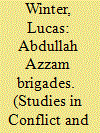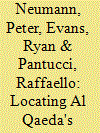|
|
|
Sort Order |
|
|
|
Items / Page
|
|
|
|
|
|
|
| Srl | Item |
| 1 |
ID:
107977


|
|
|
|
|
| Publication |
2011.
|
| Summary/Abstract |
This article looks at the growth and evolution of the The Abdullah Azzam Brigades, from the group's Egyptian origins through its most recent attack on a Japanese tanker in the Hormuz Straits. In addition to an overview of the group's main personalities and claims of responsibility, the article aims to explain the group by placing it in the context of recent jihadi theory.
|
|
|
|
|
|
|
|
|
|
|
|
|
|
|
|
| 2 |
ID:
107975


|
|
|
|
|
| Publication |
2011.
|
| Summary/Abstract |
As terrorism on all scales continues, it is necessary to improve understanding of terrorist and insurgent activities. This article takes a Geographic Information Systems (GIS) approach to advance the understanding of spatial, social, political, and cultural triggers that influence terrorism incidents. Spatial, temporal, and spatiotemporal patterns of terrorist attacks are examined to improve knowledge about terrorist systems of training, planning, and actions. The results of this study aim to provide a foundation for understanding attack patterns and tactics in emerging havens as well as inform the creation and implementation of various counterterrorism measures.
|
|
|
|
|
|
|
|
|
|
|
|
|
|
|
|
| 3 |
ID:
107972


|
|
|
|
|
| Publication |
2011.
|
| Summary/Abstract |
This article claims that the ongoing debate about the structure and dynamics of Al Qaeda has failed to appreciate the importance of an organizational layer that is situated between the top leadership and the grass-roots. Rather than being "leaderless," it is the group's middle management that holds Al Qaeda together. In Clausewitzian terms, Al Qaeda's middle managers represent a center of gravity-a "hub of … power and movement"-that facilitates the grass-roots' integration into the organization and provides the top leadership with the global reach it needs in order to carry out its terrorist campaign, especially in Europe and North America. They are, in other words, the connective tissue that makes Al Qaeda work. The article substantiates this hypothesis by providing a number of case studies of Al Qaeda middle managers, which illustrate the critical role they have played in integrating the grass-roots with the top leadership. The policy implications are both obvious and important. If neither the top leadership nor the grass-roots alone can provide Al Qaeda with strategic momentum, it will be essential to identify and neutralize the middle managers, and-in doing so-"cause the network to collapse on itself."
|
|
|
|
|
|
|
|
|
|
|
|
|
|
|
|
| 4 |
ID:
107973


|
|
|
|
|
| Publication |
2011.
|
| Summary/Abstract |
Following the terrorist attacks of 11 September 2001, the United Nations Security Council passed Resolutions 1368 and 1373 and thereby created the basis of a global counterterrorism system. At the heart of this system lies a partnership between the Security Council and the UN member states-a partnership in which states have been given considerable, independent, operational responsibility. Unfortunately, this system has often been criticized and viewed pessimistically by scholars, who tend to focus primarily on UN bodies and offer little discussion of the key role of states. This article presents a different conceptualization of this counterterrorism system and suggests, through case studies, that it has attained some important objectives in the global struggle against terrorism.
|
|
|
|
|
|
|
|
|
|
|
|
|
|
|
|
|
|
|
|
|